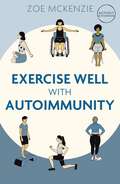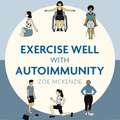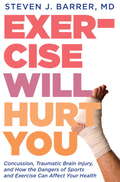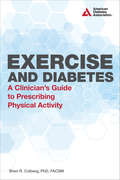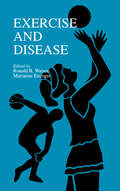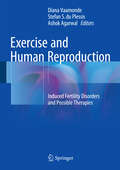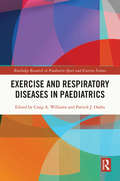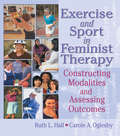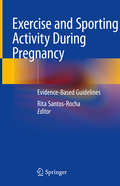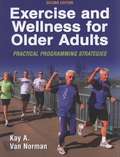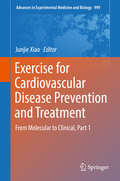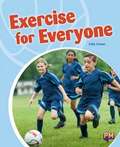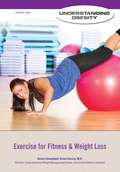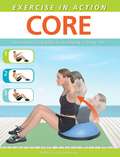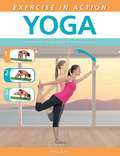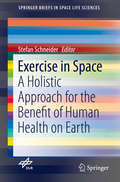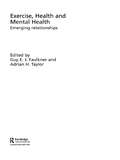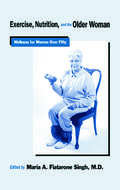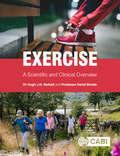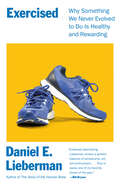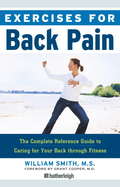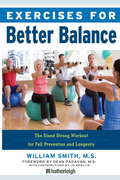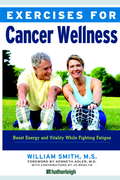- Table View
- List View
Exercise Testing and Interpretation
by Christopher B. Cooper Thomas W. StorerThis handbook provides a practical and systematic approach to the acquisition, interpretation, and reporting of physiologic responses to exercise. Pulmonologists, cardiologists, and sports physicians, as well as respiratory therapists and other allied health professionals will find this book an indispensable resource when learning to select proper instruments, identify the most appropriate test protocols, and integrate and interpret physiologic response variables. The final chapter presents clinical cases to illuminate useful strategies for exercise testing and interpretation. Useful appendices offer laboratory forms, algorithms and calculations, as well as answers to FAQs. A glossary of terms, symbols, and definitions is also included. Handbook of Exercise Testing and Interpretation: A Practical Approach offers clearly defined responses (both normal and abnormal) to over thirty performance variables including aerobic, cardiovascular, ventilatory, and gas-exchange variables. Practical, portable, and easy-to-read, this essential guidebook can be used on its own or together with a more detailed book on the subject.
Exercise Well With Autoimmunity
by Zoe MckenzieWe're told that we need to exercise to stay healthy, but we're not told HOW to exercise. We're certainly not told how to exercise with an autoimmune condition. This is the definitive book you need to help you understand and support your body when exercising with an autoimmune condition.Here, Zoe tells us of her own health journey, whilst exploring the benefits of exercise for someone with an autoimmune condition and how you can get onto a plan that suits your needs. She uses case studies, experts and her own research to explore:- the benefits of exercising with a chronic condition- the barriers to exercising with a chronic condition and how to overcome them- how to keep motivation high when exhausted - which exercises you should do (complete with illustrations)- how to adapt your exercises depending on your condition- how to get into the right mindset with exerciseZoe teaches with compassion and understanding that is unique in this field and brings to market a guide that covers all aspects of exercising with chronic conditions, including simple, clear practices that you can put into action and meld into part of your balanced lifestyle programme.
Exercise Well With Autoimmunity
by Zoe MckenzieWe're told that we need to exercise to stay healthy, but we're not told HOW to exercise. We're certainly not told how to exercise with an autoimmune condition. This is the definitive book you need to help you understand and support your body when exercising with an autoimmune condition.Here, Zoe tells us of her own health journey, whilst exploring the benefits of exercise for someone with an autoimmune condition and how you can get onto a plan that suits your needs. She uses case studies, experts and her own research to explore:- the benefits of exercising with a chronic condition- the barriers to exercising with a chronic condition and how to overcome them- how to keep motivation high when exhausted - which exercises you should do (complete with illustrations)- how to adapt your exercises depending on your condition- how to get into the right mindset with exerciseZoe teaches with compassion and understanding that is unique in this field and brings to market a guide that covers all aspects of exercising with chronic conditions, including simple, clear practices that you can put into action and meld into part of your balanced lifestyle programme.
Exercise Well With Autoimmunity
by Zoe MckenzieWe're told that we need to exercise to stay healthy, but we're not told HOW to exercise. We're certainly not told how to exercise with an autoimmune condition. This is the definitive book you need to help you understand and support your body when exercising with an autoimmune condition.Here, Zoe tells us of her own health journey, whilst exploring the benefits of exercise for someone with an autoimmune condition and how you can get onto a plan that suits your needs. She uses case studies, experts and her own research to explore:- the benefits of exercising with a chronic condition- the barriers to exercising with a chronic condition and how to overcome them- how to keep motivation high when exhausted - which exercises you should do (complete with illustrations)- how to adapt your exercises depending on your condition- how to get into the right mindset with exerciseZoe teaches with compassion and understanding that is unique in this field and brings to market a guide that covers all aspects of exercising with chronic conditions, including simple, clear practices that you can put into action and meld into part of your balanced lifestyle programme.
Exercise Will Hurt You
by Dr Steve BarrerA (Philadelphia Magazine) Top Doc's case for moderation in running, cycling, skiing, and other things we do because we think our bodies are invincible. When was it decided that exercise could only be good for you? Leading neurosurgeon Dr. Steve Barrer argues--based on his extensive career treating exercise-related injuries, a cornucopia of his own personal injuries from exercise over the years, and ample scientific data--that we ought to change the way we think about exercise. Instead of succumbing to what Barrer calls "the cult of exercise" that follows the mantra "no pain, no gain," how about some common sense? In a clear, friendly, and compelling voice, Barrer surveys exercise and sports that are commonly practiced--yoga, soccer, skiing, running--and informs the reader knowledgeably and conscientiously about the injuries that can result. We've come to believe that the body can handle the abuse that comes with these sports, but it can't. Before we get carried away with the culture of excess that has been assigned to exercise, let's remember that exercise is not always good for you, and make sure we don't get the wrong idea from the model that's been set. From the Hardcover edition.
Exercise and Diabetes
by Sheri R. ColbergPhysical movement has a positive effect on physical fitness, morbidity, and mortality in individuals with diabetes. Although exercise has long been considered a cornerstone of diabetes management, many health care providers fail to prescribe it. In addition, many fitness professionals may be unaware of the complexities of including physical activity in the management of diabetes. Giving patients or clients a full exercise prescription that take other chronic conditions commonly accompanying diabetes into account may be too time-consuming for or beyond the expertise of many health care and fitness professionals.The purpose of this book is to cover the recommended types and quantities of physical activities that can and should be undertaken by all individuals with any type of diabetes, along with precautions related to medication use and diabetes-related health complications. Medications used to control diabetes should augment lifestyle improvements like increased daily physical activity rather than replace them.Up until now, professional books with exercise information and prescriptions were not timely or interactive enough to easily provide busy professionals with access to the latest recommendations for each unique patient. However, simply instructing patients to "exercise more" is frequently not motivating or informative enough to get them regularly or safely active. This book is changing all that with its up-to-date and easy-to-prescribe exercise and physical activity recommendations and relevant case studies.Read and learn to quickly prescribe effective and appropriate exercise to everyone.
Exercise and Disease
by Marianne EisingerExercise and Disease reviews the role of exercise and physical fitness in the prevention or causation of cancer. Relevant mechanistic studies, particularly immunomodulation, are emphasized. The book also interprets effects of long-term exercise on immune functions and data that shows how exercise influences disease resistance. On the other hand, exercise may be involved in immune mediated motion injuries. Finally, exercise plays a potential role in cancer therapy. The book will be useful to researchers interested in the most recent developments and their interpretations.
Exercise and Human Reproduction
by Ashok Agarwal Diana Vaamonde Stefan S du PlessisProviding a comprehensive review of the interactions between exercise and human reproduction, this unique text focuses on both the positive and negative consequences of sport and physical activity on male and female fertility and infertility and the biological mechanisms and processes behind them. Beginning with a review of the structure and function of the male and female reproductive systems as well as fertilization and gestation, the discussion then turns to the physiology and endocrinology of sport and exercise, which is further elaborated in subsequent chapters on the impact of physical activity, hormonal changes, pathologies, and consequences of drug use for active men and women. Additional chapters address related topics, such as the impact of sport on young athletes and developing reproductive potential, physical activity and pregnancy, the use of oral contraceptives in athletes, oxidative stress, and the impact of nutritional deficiencies on athletes' fertility, with a final chapter providing recommendations and therapeutic guidelines for exercise-related reproductive disorders. Covering everything from the fundamental principles of sports physiology and human reproductive potential to the interaction between physical exercise and the endocrinology of the reproductive system, Exercise and Human Reproduction is an authoritative resource for helping clinicians understand how the reproductive system adapts to activity and exercise and offers strategies to avoid potential harm to human reproduction.
Exercise and Respiratory Diseases in Paediatrics (Routledge Research in Paediatric Sport and Exercise Science)
by Craig A. WilliamsIt is commonly accepted that "exercise is good for children" but, considering the number of children worldwide exercising, we know comparatively little, compared to adults, about how specific mechanisms influence health and sports performance. There are considerable obstacles that challenge the progress of paediatric research, not least in relation to ethical and methodological considerations. Therefore, advances in the science and clinical application of paediatric exercise physiology, psychology and biomechanics have not reached their potential. Paediatric clinical exercise physiology has application to the role of exercise in the assessment and treatment of paediatric chronic diseases, the utilization of physical activity in preventing illness and enhancing wellbeing and can enhance our understanding of how sports can be made safer and more enjoyable for our young athletes. Exercise and Respiratory Diseases in Paediatrics highlights research by various methodologies, including literature reviews, experimental research and innovations, applied to children and adolescents with respiratory diseases. Chronic conditions such as asthma, bronchiectasis (e.g., cystic fibrosis), and those associated with prematurity and medical complexity are worldwide health problems for young people and although management includes pharmaceutical medications, physiotherapy, nutritional and psychological support, exercise has a role in optimising multidisciplinary care. There has been unprecedented acceleration in new technologies and methodologies that promise to facilitate paediatric research and these are explained and discussed as future research directions. This is reading for post graduate students, researchers, academics and policy makers within the field of paediatric healthcare, physical activity, physiology and the related disciplines.
Exercise and Sport in Feminist Therapy: Constructing Modalities and Assessing Outcomes
by Ruth Hall Carole OglesbyIntegrate physical activity into feminist therapy!This book explores the healing use of exercise and sport as a helpful adjunct to therapy from several therapeutic orientations within the feminist context. It looks at the ways that feminist orientations challenge the mind-body dichotomy and explores the benefits of integrating physical activity, exercise, and sport into therapy. From the editors: "The contributors to this book display a diversity of theory and research approaches, including the integration of the exercise/sport sciences and exercise physiology. This volume is unique in that there has been comparatively little written about the use of exercise in therapy even though exercise is a wonderful and useful intervention tool in the treatment of depression, stress, anxiety disorders, and chronic pain. This book illustrates how exercise can be applied to inpatient and outpatient populations, to the neurotic, and to the chronically mentally ill. Exercise can reduce the incidence of chronic diseases, including diabetes and hypertension, as well as address physical problems such as obesity. Exercise can give one a sense of mastery and self-confidence. As our authors suggest, exercise must be tailored to specific issues and client populations and diagnoses, level of functioning, age, overall health, and cultural context must all be taken into account."Exercise and Sport in Feminist Therapy: Constructing Modalities and Assessing Outcomes examines: the theory supporting the use of physicality to enhance various types of psychotherapy-psychoanalytic, cognitive-behavioral, constructivist, narrative, and organismic/systems practical methods of integrating exercise into varied orientations an exercise program for women with fibromyalgia a way to use exercise to enhance rehabilitation from breast cancer the use of exercise in group therapy for women suffering with chronic mental illness the “tend and befriend” model, which can help clients to meet their exercise program responsibilities
Exercise and Sporting Activity During Pregnancy: Evidence-Based Guidelines
by Rita Santos-Rocha<p>This clinically and practice oriented, multidisciplinary book is intended to fill the gap between evidence-based knowledge on the benefits of physical activity and exercise during pregnancy and the implementation of exercise programmes and related health promotion measures in pregnant women. It will provide medical, sports, and fitness professionals both with the knowledge needed to allay undue fears regarding the consequences of exercising during pregnancy and with the practical expertise to offer optimal guidance on exercising to pregnant exercisers and athletes. <p>Readers will find up-to-date evidence on the psychological, social, physiological, body composition, musculoskeletal, and biomechanical changes that occur during pregnancy and their implications for physical activity and exercise. Detailed descriptions are provided of the components of exercise testing and prescription for pregnant women, the current evidence-based and practice-oriented guidelines, and exercise selection and adaptation during pregnancy. Exercises specifically targeting musculoskeletal health are discussed separately, and a concluding chapter explains the nutritional requirements in pregnant women who exercise.</p>
Exercise and Wellness for Older Adults: Practical Programming Strategies (2nd edition)
by Kay A. Van NormanThis book is an introduction to aging and wellness and is an essential guide to creating exercise and wellness programs for older adults, regardless of age or physical challenge. The text provides a framework to help readers make the critical shift from expectations of decline to an age-neutral focus on maximizing functional ability.
Exercise for Cardiovascular Disease Prevention and Treatment
by Junjie XiaoThe book provides an intensive overview on exercise for cardiovascular disease prevention and treatment, from basic research to clinical practice. The volume first summarizes the acute and chronic response to exercise. Second, evidence for exercise as medicine for the heart based on clinical studies and basic research is summarized. Third, molecular mechanisms mediating the beneficial effects of exercise including IGF-1-PI3K-AKT signalling, NO signalling, C/EBPB-Cited4 signalling, Non-coding RNAs, epigenetic regulators, mitochondria adaption and exosomes are presented. Finally, exercise dosing, prescription and future prospects are provided. This book will provide valuable reference for researchers in cell biology, physiology, as well as physician, physical therapist in cardiology, sport medicine, etc.
Exercise for Everyone (Into Reading, Level N #63)
by Sally Cowan Lindsay EdwardsNIMAC-sourced textbook <p><p> Exercise is important for everyone. Regular exercise, such as running, team sports, yoga, or playing with the dog, keeps us fit and healthy. It helps us to think clearly and do well at school, and it is a great way to make new friends. Follow the step-by-step instructions for how to do a fitness workout.
Exercise for Fitness & Weight Loss
by Autumn LibalToday, obesity--the state of being very overweight--is a problem that gets worse each year, particularly as many people spend less time exercising and more time on the couch or sitting at a computer. The health risks caused by excess weight and obesity are numerous and can be deadly. While we're learning more and more about the harmful consequences of excess weight, many people still have a hard time slimming down. Real, healthy weight loss can seem like a mystery. Explore the causes of the weight epidemic and the health risks that stem from excess weight. Discover the part that physical fitness plays in today's obesity crisis. Learn how fitness--not just slimness--should be the goal of those trying to lose weight. Make physical activity a part of your life!
Exercise in Action: Core (Exercise In Action Ser.)
by Hollis Lance LiebmanAn instant visual guide to developing strong core muscles in your body.It doesn’t matter if you’re a fitness novice or an elite athlete, or whether or not you have a gym membership. Developing a strong core is key to maintaining good health and balance, and you can do it within the comfort of your own home. It can be difficult to know which exercises to do for different parts of the body without the expertise of a professional trainer. In Exercise in Action: Core, fitness expert Hollis Lance Liebman shows everyone how to build a strong core and prevent injury.Gain a whole new perspective on your body and how to increase its performance.Learn how to get a full-body workout without leaving your home.Exercise in Action: Core provides you with everything you need to know in order to develop a strong body core.
Exercise in Action: Yoga
by Betsy KaseAn instant visual guide to learning yoga.It doesn’t matter if you’re an expert yogi or if you’re more like Yogi Bear, yoga is a practice that even the masters are always improving upon. And we can help your practice by helping you to increase flexibility, strengthen your core, improve balance, and gain a better sense of mindfulness during your poses--all of which are the key to maintaining good physical health. The good news is you don’t have to join an expensive studio; you can do it within the comfort of your own home. It can be difficult to know which poses to do for different parts of the body or to achieve different things, without the expertise of a professional instructor. In Exercise in Action: Yoga, fitness expert Steve Kane shows everyone how to improve--or even begin--their yoga practice and how to prevent injury while doing so. *Gain a whole new awareness of your body and how to increase its performance*Learn how to get a full-body yoga workout without leaving your home Exercise in Action: Yoga provides you with everything you need to get started with your yoga practice without leaving the comfort of your own home.
Exercise in Space
by Stefan SchneiderThis volume of the Series SpringerBriefs in Space Life Sciences summarizes the newest finding in the field of mental health and physiological exercise in Space. Currently two major challenges are impacting human health in the western societies, one being a move towards a sedentary society, the second one being longevity. Both have a considerable impact on physical as well as mental health. Space life science research helps to understand the underlying degenerative physiological and neuro-psychological processes as living in space, living in microgravity can be regarded as a time lapse of the sedentary and aging human being. Translational research of the past years has shown that exercise can be regarded as a key factor to counteract physical and mental deconditioning in space, guaranteeing a holistic approach to health and a benefit to the socio-demographic changes of our society. The book is written for scientists in biomedicine, more specific in aging research, sports physiology and neurosciences.
Exercise, Health and Mental Health: Emerging Relationships
by Guy E.J. Faulkner Adrian H. TaylorExercise, Health and Mental Health provides an introduction to this emerging field and a platform for future research and practice. Written by internationally acclaimed exercise, health and medical scientists, it is the first systematic review of the evidence for the potential role of exercise in: treating and managing mental health problems including dementia, schizophrenia, drug and alcohol dependence coping with chronic clinical conditions including cancer, heart disease and HIV/AIDS enhancing well-being in the general population – by improving sleep, assisting in smoking cessation, and as a way of addressing broader social issues such as anti-social behaviour. Adopting a consistent and accessible format, the research findings for each topic are clearly summarized and critically examined for their implications.
Exercise, Nutrition and the Older Woman: Wellness for Women Over Fifty
by Maria A. Fiatarone SinghExercise, Nutrition and the Older Woman: Wellness for Women Over Fifty is a comprehensive guide to the major wellness issues for women over fifty. The author is a physician who explores diet, exercise and lifestyle choices from a medical perspective. The book assists in the design and implementation of programs to optimize good health and quality o
Exercise: A Scientific and Clinical Overview
by Dr Hugh J. Bethell Professor David BrodieThis book is about exercise - what it is, how it affects the individual, how it is measured and most of all what benefits it brings. Beginning with an introduction to the history and biology of exercise, the authors review the interactions between exercise and specific diseases, such as diabetes, coronary heart disease, cancer and many more, before considering exercise in a wider health context. The book covers: - Current societal norms, as well as the social and economic costs of inactivity. - Exercise for life - from starting young, to pregnancy, longevity and frailty. - Complications of exercise. - The intersections of behavioural psychology and exercise, such as encouragement and excuse making. With comprehensive and clear explanations based on sound science, yet written in an approachable and accessible style, this book is a valuable resource for students of medicine, public health, physiotherapy, sports science, coaching and training.
Exercised: Why Something We Never Evolved to Do Is Healthy and Rewarding
by Daniel LiebermanIf exercise is healthy (so good for you!), why do many people dislike or avoid it? These engaging stories and explanations will revolutionize the way you think about exercising—not to mention sitting, sleeping, sprinting, weight lifting, playing, fighting, walking, jogging, and even dancing.&“Strikes a perfect balance of scholarship, wit, and enthusiasm.&” —Bill Bryson, New York Times best-selling author of The Body · If we are born to walk and run, why do most of us take it easy whenever possible?· Does running ruin your knees?· Should we do weights, cardio, or high-intensity training?· Is sitting really the new smoking?· Can you lose weight by walking?· And how do we make sense of the conflicting, anxiety-inducing information about rest, physical activity, and exercise with which we are bombarded? In this myth-busting book, Daniel Lieberman, professor of human evolutionary biology at Harvard University and a pioneering researcher on the evolution of human physical activity, tells the story of how we never evolved to exercise—to do voluntary physical activity for the sake of health. Using his own research and experiences throughout the world, Lieberman recounts without jargon how and why humans evolved to walk, run, dig, and do other necessary and rewarding physical activities while avoiding needless exertion. Exercised is entertaining and enlightening but also constructive. As our increasingly sedentary lifestyles have contributed to skyrocketing rates of obesity and diseases such as diabetes, Lieberman audaciously argues that to become more active we need to do more than medicalize and commodify exercise. Drawing on insights from evolutionary biology and anthropology, Lieberman suggests how we can make exercise more enjoyable, rather than shaming and blaming people for avoiding it. He also tackles the question of whether you can exercise too much, even as he explains why exercise can reduce our vulnerability to the diseases mostly likely to make us sick and kill us.
Exercises for Back Pain
by William Smith Grant CooperA convenient, cost-effective opportunity to alleviating the stiffness, lack of mobility, and decreased daily function that result from chronic back pain. Back pain is no small issue. In the US, acute lower back pain is the fifth leading cause for doctor visits. About 9 out of 10 adults experience back pain at some point in their lives, and 5 out of 10 working adults suffer from back pain at some point every year.Exercises for Back Pain helps you to understand the root cause of your discomfort, how back pain affects on your overall health and well being, and practical exercises you can use to treat the pain. It includes rehabilitative exercise regimes for both men and women who suffer from back pain or those who have undergone back surgery. Exercises for Back Pain features:* Up-to-date clinical treatments on back pain* Specific exercises that strengthen the back* A training log to track your progressEasy-to-follow photograph sequences with clear instructions make the healing process a simpler one. Written by Wiliam Smith, MS, NSCA, CSCS, MEPD, Exercises for Back Pain will help you to achieve a healthier, happier, more productive life.
Exercises for Better Balance: The Stand Strong Workout for Fall Prevention and Longevity
by William Smith Jo Brielyn M.D. Dean PadavanIMPROVE YOUR BALANCE WITH THE STAND STRONG PROGRAMGood balance is essential. Recent scientific studies point to good balance as an indicator for longevity.As we age, our balance and coordination begin to diminish, leading to a higher risk of falls. In fact, falls are the leading cause of injury among Americans over age 65. The Stand Strong workout presented in this handbook will guide you to improved balance through simple, easy to follow exercises.Now you can reclaim your independence and restore your confidence by improving your coordination and regaining your sense of balance by using Exercises for Better Balance as your guide to freedom and mobility, while helping you to lessen the risks of falls, improve your posture, and restore motor control, all while increasing your strength and energy.Exercises for Better Balance builds balance through resistance exercises, flexibility, and cardiovascular activities that fit any schedule.Exercises for Better Balance includes:- A detailed overview of how exercise can help improve balance- Clear, informative pictures of safe, effective exercises- Detailed instructions on how to perform each movement- A complete fitness approach to recovering balance- A training log to track your progressFeaturing expert-approved fitness techniques, with options ranging from resistance training to mobility movements, Exercises for Better Balance is the all-in-one resource for anyone looking to stand strong and walk proud!From the Trade Paperback edition.
Exercises for Cancer Wellness: Restoring Energy and Vitality While Fighting Fatigue
by William Smith Jo Brielyn Kenneth AdlerIMPROVE YOUR ENERGY AND STRENGTH WITH EXERCISEExercise helps to build a stronger, healthier you, better suited to combat the symptoms and side effects associated with cancer and its treatments.Exercises for Cancer Wellness is your guide to making positive life changes during and after cancer treatment, helping to lessen the risks of recurrence or relapse, while increasing your strength and energy.Exercises for Cancer Wellness is fine-tuned to improve your fitness without strain, pain and stiffness. With a focus on gentle resistance exercises, flexibility, and cardiovascular activities, you will find yourself feeling better each day, as your strength increases and your fatigue decreases.Exercises for Cancer Wellness includes:- A detailed overview of how exercise can help reduce your risk factors- Clear, informative pictures of safe, effective exercises- Detailed instructions on how to perform each movement- A complete fitness approach to reduce stress and improve health- A training log to track your progressLeveraging a wide spectrum of proven-effective exercise techniques, from resistance training to yoga, Exercises for Cancer Wellness provides an excellent resource for all patients.From the Trade Paperback edition.

